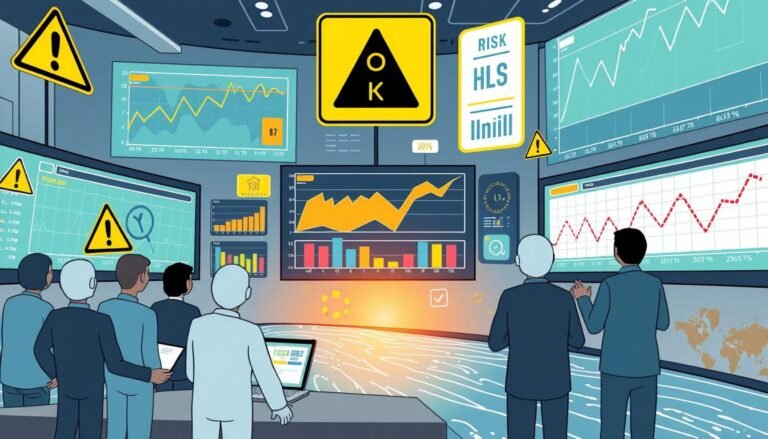Risk Mitigation Leadership
“The pessimist complains about the wind; the optimist expects it to change; the realist adjusts the sails.” This quote by William Arthur Ward captures the heart of Risk Mitigation Leadership today. As the world changes, leaders must adjust and plan to face the unknown.
A study with 300 top executives showed that companies that made it through tough times had a risk-aware culture. These companies didn’t just survive; they thrived by managing risks well. This highlights the key role of Risk Mitigation Leadership in building strong organizations.
Strategic Risk Planning is not just about avoiding problems; it’s about finding chances. Leaders who excel in Crisis Management face tough questions head-on. They value diverse views, making sure to listen to everyone. This approach helps successful companies stand out when times are hard.
Effective leaders show integrity, courage, and compassion in crises. They know their choices affect many and take responsibility for managing risks. This human touch in Risk Mitigation Leadership builds trust and makes organizations stronger.
Key Takeaways
- Successful risk management requires a culture attuned to potential risks
- Diverse perspectives lead to better risk assessment and decision-making
- Effective leaders exhibit integrity, courage, and compassion during crises
- Risk Mitigation Leadership goes beyond policies to personal responsibility
- Inclusive decision-making processes contribute to organizational resilience
Understanding the Foundations of Risk Mitigation Leadership
Risk mitigation leadership is key to keeping operations strong. It’s about building a culture that gets ready for challenges and acts fast. Leaders who get this right help keep businesses running smoothly and build strong risk management systems.
Defining Risk Management Culture
A strong risk management culture is essential for success. It means being smart with money and learning from mistakes quickly. This helps companies stay ahead in a changing market and stay resilient.
The Role of Leadership Integrity
Leadership integrity is vital in uncertain times. Leaders need to understand risks and have clear plans. They must stay alert to keep businesses running smoothly, even when things get tough.
Building Organizational Resilience
Building resilience means planning for different scenarios, talking clearly, and working together. Using new technology helps assess risks better. This makes the organization stronger and ready for what’s next.
| Risk Mitigation Strategy | Description | Impact on Business Continuity |
|---|---|---|
| Risk Reduction | Implementing measures to decrease likelihood or impact of risks | Enhances operational stability |
| Risk Transfer | Shifting risk responsibility to third parties (e.g., insurance) | Provides financial protection |
| Risk Avoidance | Eliminating activities that pose significant risks | Ensures focus on core competencies |
| Risk Acceptance | Acknowledging and preparing for unavoidable risks | Allows for strategic resource allocation |
By understanding these basics, leaders can build a solid risk management plan. This ensures their operations are resilient and their risk governance is effective.
Risk Mitigation Leadership in Modern Business
In today’s fast-paced business world, effective risk mitigation leadership is crucial. Companies that embrace strategic risk management are five times more likely to build stakeholder confidence and achieve better outcomes. This approach also doubles the chances of faster revenue growth compared to organizations that neglect it.
Proactive Decision-Making Approaches
Leaders must adopt proactive strategies to navigate potential risks. This includes regular assessments, implementing robust security controls, and developing continuity plans. By identifying risks early, businesses can avoid costly mistakes. For instance, workplace misconduct cases in 2021 cost U.S. companies over $20 billion, highlighting the need for preventive measures.
Stakeholder Communication and Engagement
Effective stakeholder engagement is vital for building trust and ensuring preparedness. Leaders should foster open communication channels and keep all parties informed about potential risks and mitigation strategies. This transparency can help avoid situations like Volkswagen’s $25 billion penalty in 2018 due to emissions data manipulation.
Risk Analytics and Data-Driven Solutions
Risk analytics play a crucial role in modern risk mitigation. Data-driven solutions help leaders make informed decisions and predict potential threats. With 78% of managers citing cybersecurity as the top business risk, leveraging analytics becomes essential for developing a strong risk culture.
- Identify potential risks early
- Develop strategies aligned with risk types
- Use data to inform decision-making
- Regularly review and update risk management protocols
By integrating these approaches, businesses can create a robust risk management framework that supports growth while safeguarding against potential threats. This balanced approach is key to thriving in today’s complex business landscape.
Strategic Risk Planning and Implementation
Strategic risk planning is crucial for managing risks. It helps leaders identify and tackle risks that could harm their goals. They must focus on the most severe and impactful risks first.
To put a strategic risk plan into action, clear steps for identifying and handling risks are needed. This includes using training and security to lower risk. It’s also important to give teams the tools and freedom to make decisions.
Being proactive in risk management is essential. Companies use different tools to manage risks:
- SWOT analysis for evaluating strengths, weaknesses, opportunities, and threats
- Scenario planning to analyze potential future risks
- Data analytics to identify patterns and potential risks
- Supplier Risk Management (SRM) to assess supply chain risks
- Enterprise Risk Management (ERM) for a holistic risk assessment approach
Leaders must make smart choices about risks. They can accept, reduce, or share risks. Metrics like economic capital and RAROC help measure how well risk management works.
| Strategic Risk Management Steps | Description |
|---|---|
| Define business strategy and objectives | Align risk management with organizational goals |
| Establish key performance indicators (KPIs) | Set measurable targets for success |
| Identify variability-driving risks | Pinpoint factors that could impact performance |
| Set key risk indicators (KRIs) and tolerance levels | Define acceptable risk thresholds |
| Provide integrated risk reporting and monitoring | Continuously track and assess risk management effectiveness |
By following these steps, organizations can build a strong framework for managing risks. This leads to better decision-making and risk management.
Developing a Risk-Aware Culture and Leadership Framework
A risk-aware culture is key to good Risk Governance. It helps organizations make smart choices and stay strong. Let’s look at how to build this important framework.
Training and Empowering Team Members
Good risk management starts with a well-trained team. By teaching them about risks, organizations prepare them to face challenges. This makes the team more proactive and ready to solve problems.
Establishing Clear Risk Management Protocols
Having clear rules is crucial for Risk Governance. These rules should match the organization’s goals and help make smart decisions. A strong system has clear roles, duties, and a shared risk approach for everyone.
Creating Effective Response Mechanisms
Being quick and effective in responding to risks is essential. Organizations need plans and systems for fast action. Using charts and metrics helps see risks clearly, making decisions faster when it matters most.
Fostering Open Communication Channels
Good communication is key for a strong Risk Culture. It makes things open, accountable, and diverse. When employees feel safe to share risks, issues get solved fast, keeping the organization strong.
| Element | Impact on Risk Culture |
|---|---|
| Leadership Involvement | Crucial for prioritizing and building strong risk culture |
| Clear Risk Policies | Establish guidelines for consistent risk management |
| Risk Training | Empowers employees to make informed decisions |
| Open Communication | Promotes transparency and proactive risk reporting |
Conclusion: The Future of Risk Management Leadership
Risk Mitigation Leadership is changing fast in our complex world. Data breaches could cost $5 trillion by 2024. Leaders need new strategies for Business Continuity. Big data analytics and AI are key for spotting threats early.
The FERMA-McKinsey survey shows good signs. Almost 60% of executives think their companies are resilient. This confidence is key as we face new challenges in Crisis Management. But, there’s still work to do.
Only half of executives use scenario planning often. This is important for keeping businesses safe for the future. Risk management leaders must build a culture that’s aware of risks.
This includes using ESG risk scores and always watching for changes. By being proactive and quick to respond, companies can do well in a changing world. The future of Risk Mitigation Leadership is about using technology, talking openly, and building a strong team.
Source Links
- The Role of Leadership in Managing Risk – Ivey Business Journal
- Council Post: 20 Tips To Help Leaders Effectively Manage Risk And Uncertainty
- Leadership In The Land Of Urgency: Risk Mitigation Vs. Risk Response – CauseLabs
- Risk Mitigation: Overview, Types & Best Practices | AuditBoard
- What is Risk Mitigation? The Four Types and How to Apply Them
- What Is Risk Management & Why Is It Important? | HBS Online
- Tips to protect your business from risk [2024]
- Strategic Risk Management: Overview and Guide | AuditBoard
- 5 Steps to Effective Strategic Risk Management
- How to Develop a Risk Culture at Your Organization
- Risk Culture and Leadership: Building a Foundation for Effective ERM
- The Future Emerging Trends in Risk Management – Key Highlights for 2024 & Beyond
- From risk management to strategic resilience








